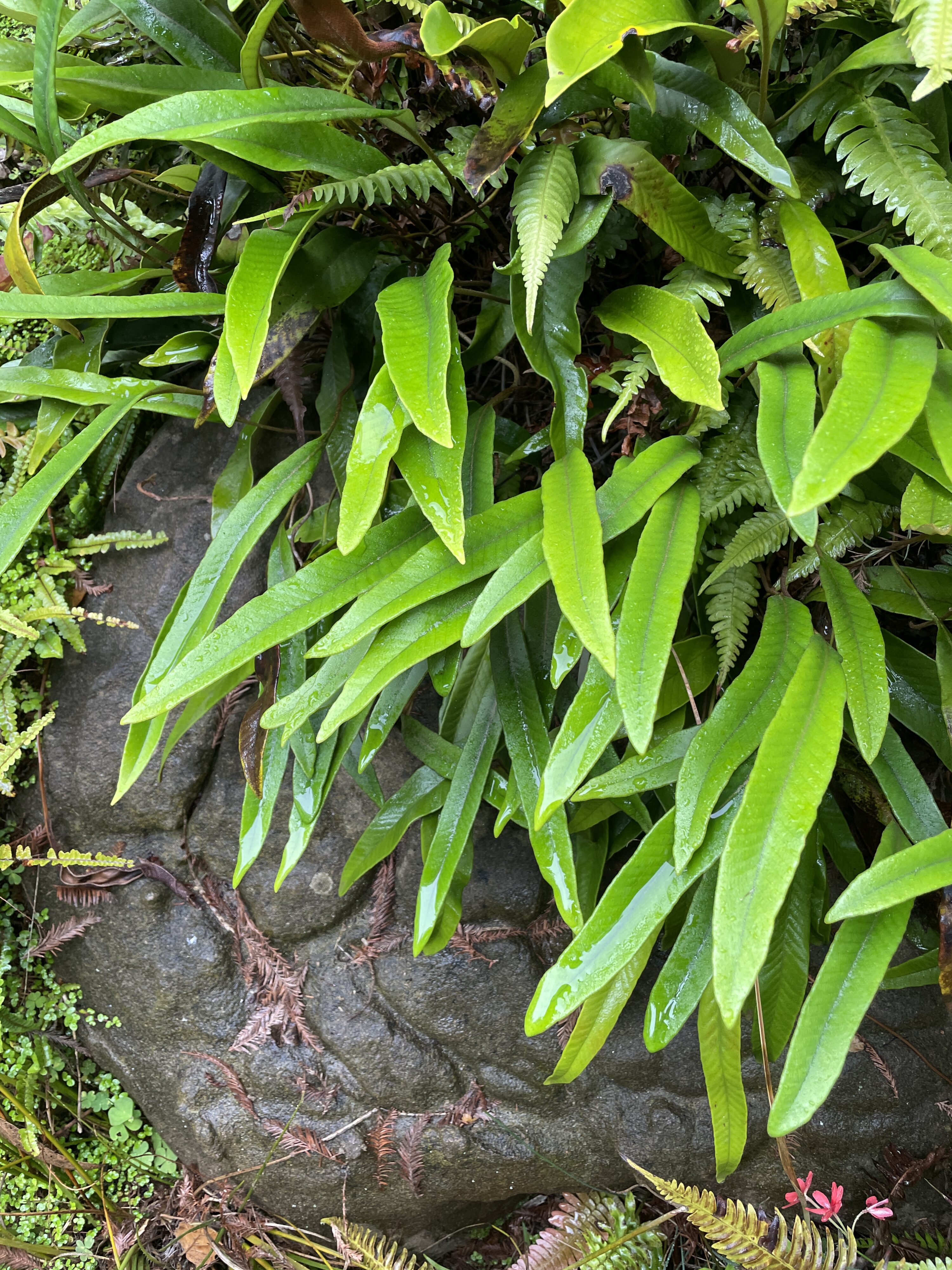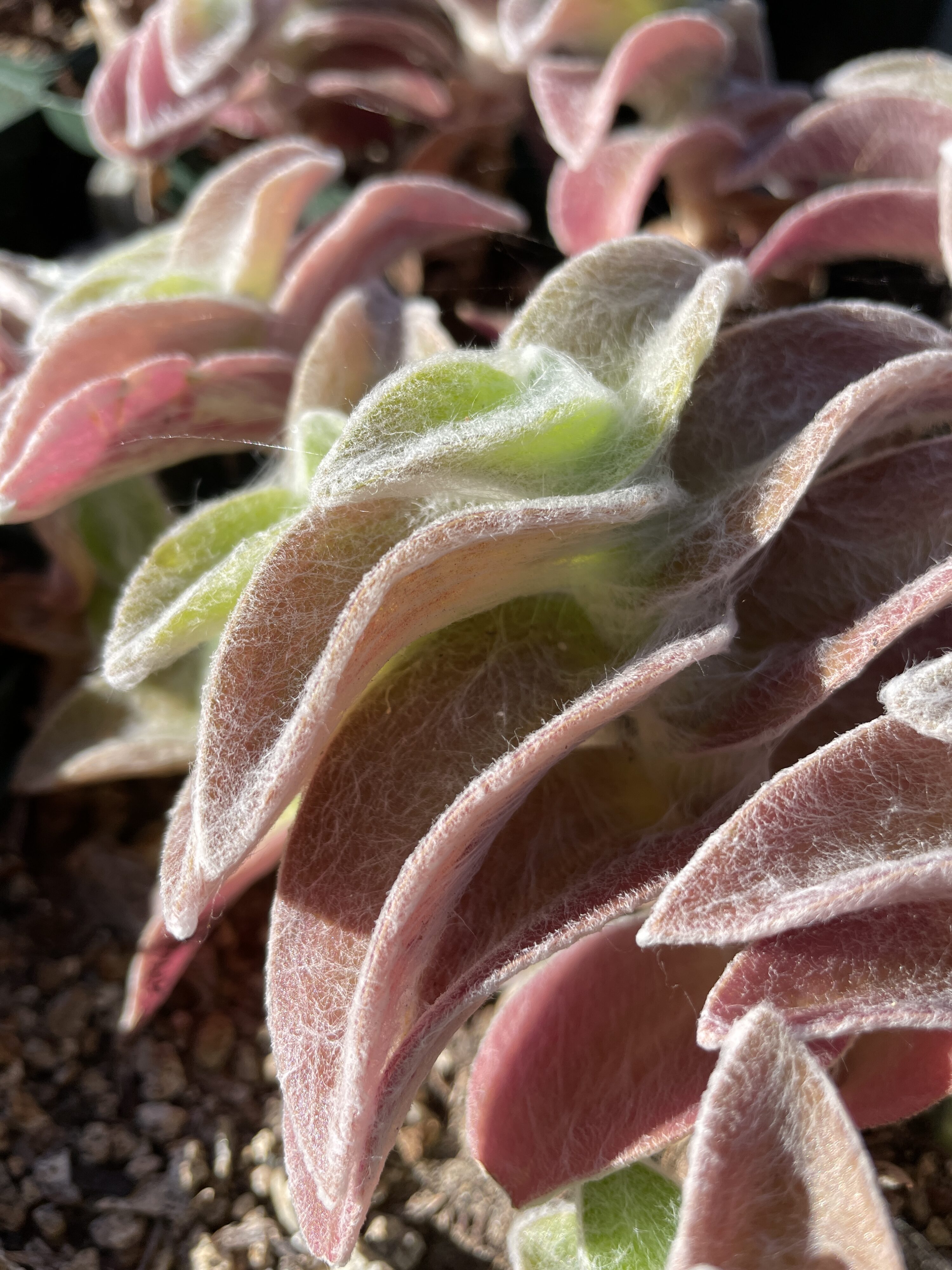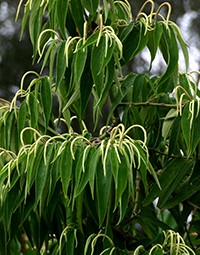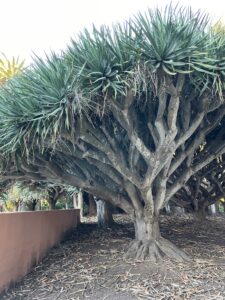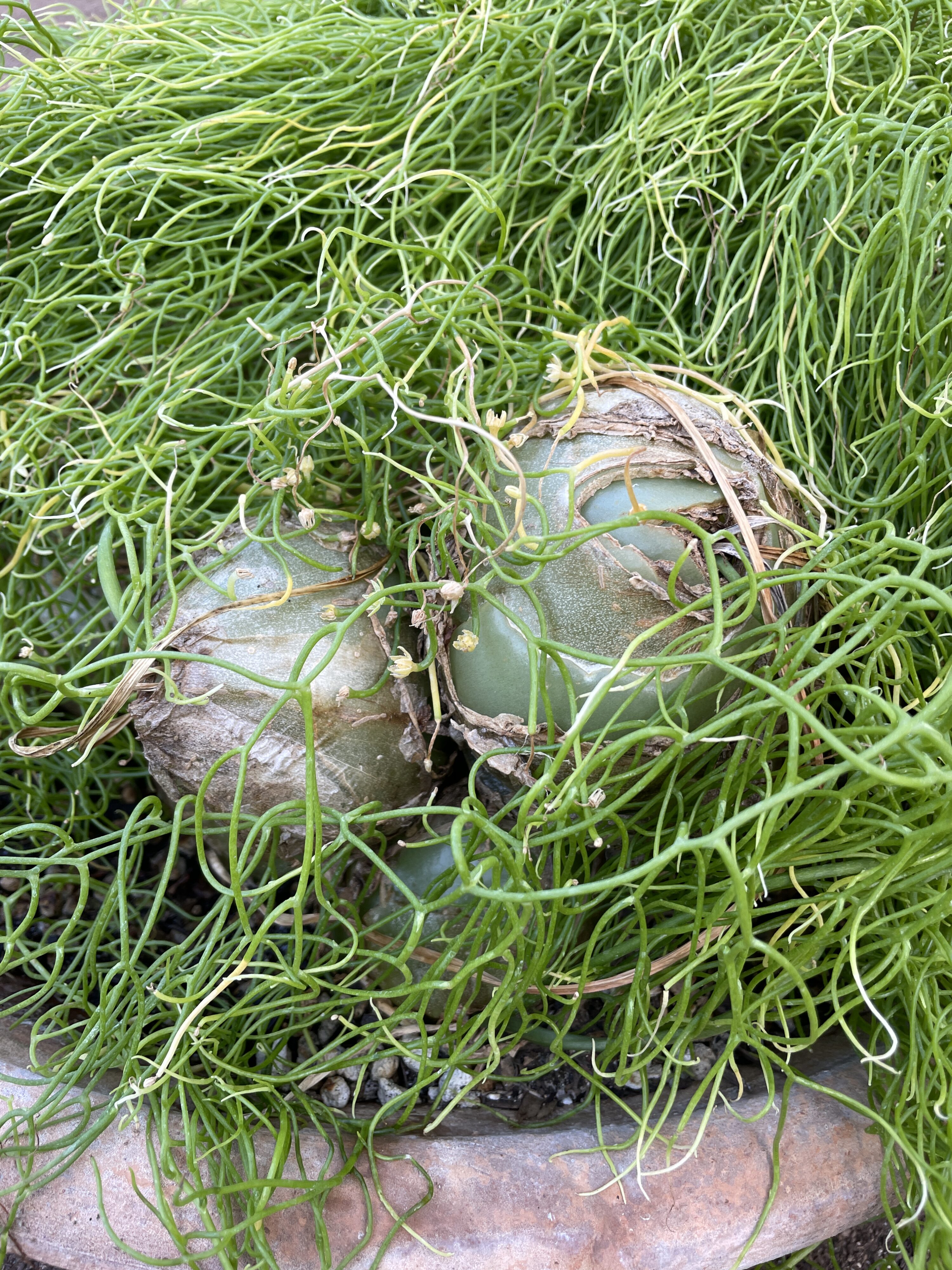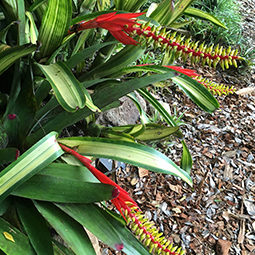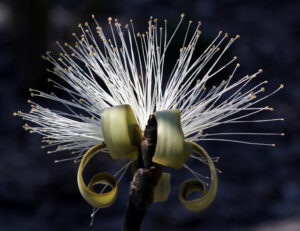The public tour season for 2024 is now closed. The Garden re-opens for public tours on February 15. We look forward to welcoming you in 2025.
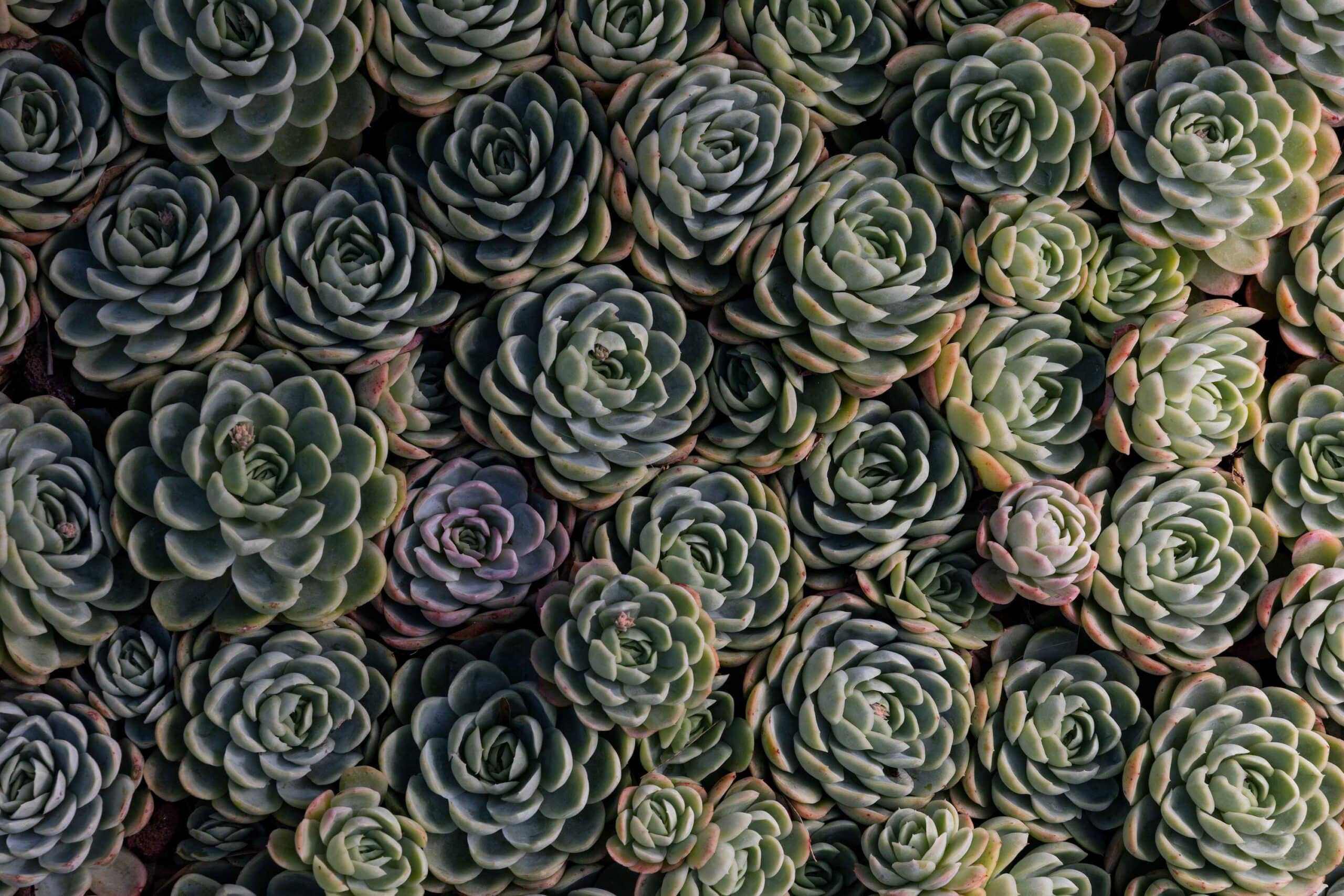
Plant Highlights
June
-
Tetrapanax papyrifer
rice paper plant, tung-tsao, bok-shung
Highlight Month:
June
Nativity:
Tetrapanax papyrifer is a fast-growing, sub-tropical shrub or tree from Taiwan and southern and central China. It is difficult to pinpoint its exact location of origin as it is widely grown across Asia for both ornamental and medicinal uses.
Growth Habit:
Check out our new Tetrapanax papyrifer next time you enter the Tropical Garden from the Main Drive at Lotusland. A small specimen was planted in January of this year, but it will quickly attain heights of 10 feet and can form a many-branched colony. In our climate, this species is semi-deciduous to evergreen, and our plant recently leafed out again after its brief winter dormancy.
The genus Tetrapanax is a member of the aralia or ginseng family (Araliaceae) and contains only one species. Other well-known genera in this family include: Aralia, Cussonia, Fatsia, Hedera, Pseudopanax, Heptapleurum, Schefflera, and Trevesia. The genus name refers to the flowers being held in groups of four (tetra) and its resemblance to the genus Panax. The inflorescence is a terminal panicle of round umbels holding creamy-white flowers and develops in late fall/early winter. T. papyrifer leaves are palmately lobed and covered in pale brown stellate hairs.
Growing Requirements:
T. papyrifer is hardy to USDA Zone 7b. When grown north of Zone 8 it may die back to the ground but will resprout from root suckers. It prefers full sun to partial shade.
Features:
Pith extracted from the branches is utilized in traditional Chinese medicine and was historically used to manufacture a paper-like substance. Small sheets of this pith-paper were carefully cut for watercolor paintings and artificial flower-making and, when introduced to Europe in the 1820’s, became known under the misnomer “rice paper.” Many of the pith paintings were sold as souvenirs to European tourists and depicted plants, animals, and scenes of life in China.
Where at Lotusland:
Tropical Garden
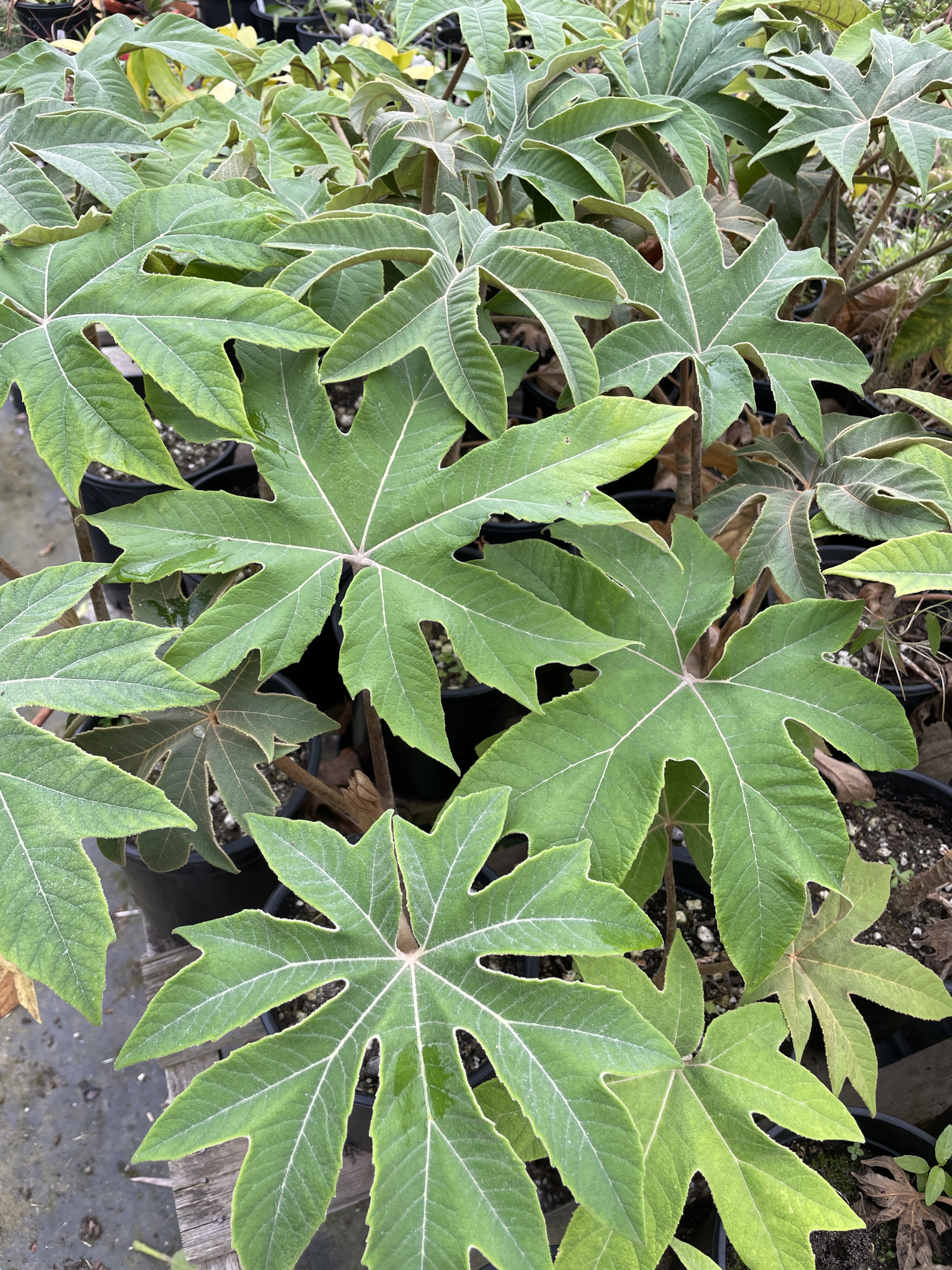
-
Pyrrosia lingua
tongue fern, Japanese felt fern, shi wei
Highlight Month:
June
Nativity:
Pyrrosia lingua is an adaptable fern capable of growing in a variety of habitats within the garden. It is native to China, Southeast Asia, and India, where its shallow creeping rhizomes cling to tree branches and dry rocks at elevations of 320-6200 ft.
Growth Habit:
This evergreen fern displays undulating simple fronds with a slight twist reaching 12-18” high. The leaves are subdimorphic, with fertile (spore bearing) and non-fertile (non-spore bearing) fronds of slightly different sizes. Stellate (star-shaped) hairs cover the leaf undersides, giving them a whitish cast in contrast to the olive-green upper surfaces. As the brown sporangia develop and release their spores later in the year, the fertile frond undersides change to a cinnamon-brown color.
Growing Requirements:
If grown in a container add orchid bark for enhanced drainage. P. lingua is hardy to USDA Zone 6 and prefers light shade to part sun.
Features:
The genus name comes from the Greek, pyr, meaning fire, in reference to the reddish scaly covering on the blade of the type species, Pyrrosia stigmosa. The specific epithet, lingua, means tongue-like, due to the slender leaf shape. The whole plant is used in traditional Chinese medicine as a diuretic.
There are numerous cultivars of P. lingua selected for interesting leaf shape, color, and variegation. Some examples include: ‘Corymbifera’ (crested leaves), ‘Alabama Gold’ (yellow-flushed leaves), ‘Eboshi’ (curled leaves), ‘Tachiba Koryu’ (ruffled margins), and ‘O Kan’ (horizontal banded variegation).
Where at Lotusland:
At Lotusland, it grows happily on tufa stones, in hanging baskets, and in the ground in the Fern Garden and Lower Bromeliad Garden near the Rooster Grotto.
-
Tradescantia sillamontana
cobweb spiderwort
Highlight Month:
June
Nativity:
Tradescantia sillamontana is native to dry regions of Mexico (Nuevo León).
Growth Habit:
This unique dry-growing Tradescantia has a delightful fuzzy leaf covering that resembles silvery cobwebs. Flowers are magenta and have three petals, typical of plants in the Commelinaceae or spiderwort family. This is a great specimen for containers, hanging baskets, or can be nestled in between rocks in a succulent garden.
Growing Requirements:
When grown in full sun it develops a compact habit and purple coloration to the leaves whereas plants grown in shade tend to be more elongated and greener. It is hardy to USDA Zones 7-10 and will die back to dormant buds in the winter. During this time watering should be infrequent.
Features:
This species was named in 1955 by Japanese-born Mexican botanist Eizi Matuda for Cerro de la Silla, a saddle or chair-shaped mountain, located adjacent to the city of Monterrey, Nuevo León.
Where at Lotusland:
This plant can be found at Lotusland in a pot in the Pavilion Patio and in the Succulent Garden.
-
Piper aduncum
spiked pepper
Highlight Month:
June
Nativity:
Mexico to Tropical America
Growth Habit:
This peppercorn relative forms a large shrub/small tree. In summer the white “rat tail” inflorescences are eyecatching.
Growing Requirements:
While native to the tropics and subtropics, this evergreen shrub is quite drought tolerant. It thrives in full to partial sun.
Features:
There are many indigenous names for this plant, but “matico” is widely used in South America where it is used medicinally as a styptic or anti-hemorrhagic remedy.
Where at Lotusland:
At the edge of the Cycad Garden nearest the Tropical Garden.
-
Brachychiton acerifolius
flame tree
Highlight Month:
June
Nativity:
Eastern Australia
Growth Habit:
A tree to 60 feet tall and 30 feet wide.
Growing Requirements:
Full sun, needs little to moderate water once established. Grows best in well-drained soil.
Features:
B. acerifolius has unusual deeply-lobed foliage, which goes deciduous for a time in late winter, and a swollen, bottle-shaped trunk. Its most striking feature is a spectacular display of bright red flowers in late spring/early summer. The flowers are followed by large brown fruits which may hang on the tree for months.
Where at Lotusland:
B. acerifolius are planted in the Australian Garden, the area around the Visitors’ Center.
-
Dracaena draco
dragon tree, dragon’s blood tree
Highlight Month:
June
Nativity:
Canary Islands, Madeira Island and the Cape Verde Islands
Growth Habit:
A very slow growing tree. The plant may take up to ten or fifteen years to flower, at which point it will branch for the first time. It will eventually form a large multi-stemmed tree up to 20 feet tall and wide.
Growing Requirements:
Dracaena are succulent plants, and will grow in full sun or light shade, with moderate water, preferably in well-drained soil. They need a climate where winters stay mainly above freezing, as the leaves are frost-sensitive and the plants die at around 25 degrees. They grow well on the coast.
Features:
The leaves are sword-shaped and have a sharp tip. Small, creamy-white flowers are borne in branched spikes. The small, round fruit are fleshy and bright orange. Old specimens have scaly brown bark. The name “dragon’s blood tree” comes from the plant’s red sap, which was used in ancient Egypt as part of the embalming process and has been used in making paint and varnishes.
Where at Lotusland:
Over 60 Dracaena draco are planted in front of the Main House, the largest specimen in the middle dating back to Ralph Kinton Stevens’ ownership of the property when the area was his demonstration nursery. The remaning D. draco were added by Madame Ganna Walska to create a mass planting.
-
Bowiea volubilis
climbing onion
Highlight Month:
June
Nativity:
Uganda to South Africa
Growth Habit:
These true bulbs produce scrambling, photosynthetic inflorescences (up to 15′ long) that emerge from succulent bulb scales. The inflorescences can be trained to grow upward with support or they will spread along the ground. They are summer growers.
Growing Requirements:
Grows best in sun to partial shade in well-drained soil. The plant should be watered very little during its deciduous dormant season. Begin regular watering when new stems start to grow from the top of the bulb. This plant is not frost-tolerant.
Features:
Bowiea is a monotypic genus represented by one species, Bowiea volubilis, with two subspecies, ssp. volubilis and ssp. gariepensis. Subspecies B. volubilis ssp. gariepensis is a winter grower with larger flowers and is found in Namibia to the Northwestern Cape Province. All parts of the plant are poisonous but are used in traditional medicine in Africa.
Where at Lotusland:
Succulent Garden
-
Rosa ‘WEKpaltlez’ HOT COCOA
Hot Cocoa floribunda rose
Highlight Month:
June
Nativity:
Garden Origin
Growth Habit:
Compact shrubs to 3 feet with glossy green leaves.
Growing Requirements:
Full sun and regular water. Mulch to maintain even moisture. Prune in dormant season as for any rose. Deadhead regularly to encourage more blooms.
Features:
This floribunda rose was an All-American Rose Selection in 2003. Smoky orange blossoms tinged with purple as they age are showy and unique.
Where at Lotusland:
Rose Garden
-
Aechmea nudicaulis var. cuspidata (variegated)
Highlight Month:
June
Nativity:
Brazil
Growth Habit:
The vase-like rosette of leaves of this bromeliad is pale yellow striped with apple green and have black spines along the margins. The bright red-bracted flower spikes produce lemon yellow flowers in summer. While the original plant will die after flowering, it will produce several offsets that may be removed and replanted. It is usually epiphytic in its native range, but adapts well to containers or raised beds outdoors.
Growing Requirements:
Grow Aechmea nudicaulis var. cuspidata in bright shade either in a pot or in the ground with lots or organic material incorporated into the soil mix. Soil may be allowed to dry out between waterings, but maintain the central cup – made by the tightly overlapping leaves – full of water at all times. Fertilize every month or two with half-strength liquid fertilizer in the central cup.
Features:
The colorful flower spikes and brightly variegated leaves make this one of the most handsome bromeliads to grow.
Where at Lotusland:
Upper Bromeliad Garden at the edge of the Main Lawn.
-
Pseudobombax ellipticum
shaving brush tree
Highlight Month:
June
Nativity:
Mexico to Guatemala
Growth Habit:
This is a small tree – to 20 feet in cultivation with thick stems and sometimes even forming a swollen base or caudex. It is deciduous in winter and flowers before the large, green leaves are produced in early summer.
Growing Requirements:
Somewhat tolerant of light frosts, the shaving brush tree does best in subtropical or tropical zones. It can be grown as a potted specimen where it will be more likely to form a caudex.
Features:
The large – 4 inches or more – flowers have sturdy greenish brown sepals that curl below the showy cluster of many stamens. There are both pink and white forms.
Where at Lotusland:
Cycad Garden


